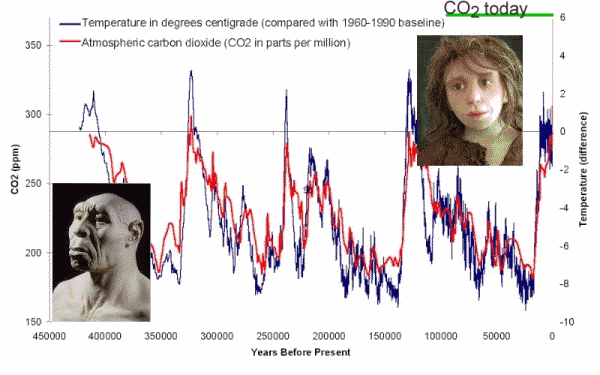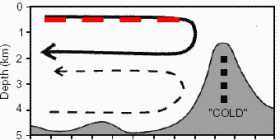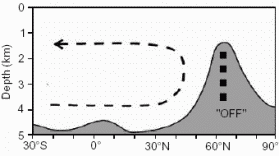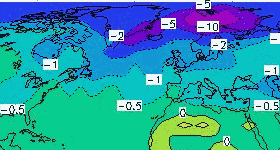|
|
 |
Abrupt climate change - Is a new ice age possible?
If global warming should lead to an interruption of the North Atlantic Stream, it will become cooler in Europe and the Northeast of America. But a new ice age is not possible.
|
|
We know about the climate history of the last 400,000 years, for example from an ice core which has been drilled at the Vostok station in Antarctica. On the image below we see that glacial and warm times alternate in a cycle with a period of about 100,000 years. The main reason for this is the orbit of the Earth around the sun. It changes periodically between two states, a nearly circular orbit and an elliptic orbit. The change takes place about every 100,000 years. We call this the Milankovitch cycle.
|
 |
 |
|
Data about the climate of the past from the Vostok ice core + 2 artist's representations of our ancestors living at this time: The graphic shows that humans slowly developed during the recent ice ages and interglacials. The present warm time is very stable and from the astronomic data we do not expect an ice age during the next millenia. Moreover, the diagram shows, that there is a relation between CO2 concentrations in the air (red) and the temperature (blue). Since there has never been as much CO2 in the air than today (green bar top right), an ice age is additionally hindered by this effect.
|
|
However, the potential cooling in the northern Atlantic is not just an invention by the producers of the film 'The day after tomorrow'. In fact there are three states in the North Atlantic circulation: in the ice age the warm current does not reach as far as the northern polar region, during the warm times the warm current reaches further into the northern polar region, or the current can not exist at all during a so called Heinrich event. A mountain chain in the ocean marks the border between the two sea basins the North Atlantic stream reaches on the one hand during the ice age on the other hand during interglacials. At his chain the ocean is less deep and Iceland and the Faroer Islands even stick out of the water. This barrier is shown on the figures by big black dots.
|
 |
 |
|
During ice ages the warm stream stops in front of the 'barrier'. Further in the north the sea is covered by ice.
|
|
 |
During the ice ages, as well as during the present warm time, an ocean current goes up to a certain limit to the north. The water penetrates slowly into cold regions and ice is formed. The remaining water bearing the ice becomes saltier and therefore heavier and due to the decreasing temperature in the polar region, the surface water also becomes heavier. Finally it sinks (black arrow downwards in the profiles) and forms 'deep water'. |
|
And when is the ocean stream disrupted? |
 |
 |
|
The so called 'Heinrich Modus' is a state, when deep water is not formed anymore. The current stops.
Graphics: modified by Elmar Uherek, original: Stefan Rahmstorf in Nature
|
|
 |
While the ice is melting in a period of continuous warming (for example at the end of an ice age), too much fresh water from the molten ice can sometimes mix into the North Atlantic. Furthermore, the surface water becomes warmer, while the deep sea is still cold. The water cannot sink. In this case the ocean circulation may temporarily stop in the respective region. We call this state 'Heinrich event'. In the worst case scientists regard it as possible, that the global warming could cause a strong melting of ice, which could lead to this state in the northern Atlantic. The Gulf Stream itself would not stop, because it is driven by winds. But without the warm water supply from the North Atlantic Stream, regions in Europe and Northeast America could cool down, despite the global warming.
|
The authors of the Pentagon study regard the temporary cooling 8200 years ago as an example of a Heinrich event. A research group has simulated in a climate model what the situation could have looked like. We can see that apart from a small region around the North Pole the cooling in Europe and North America was rather moderate, 1-2°C. But such model predictions are very uncertain.
|
 |
 |
 |
|
Modelling of the cooling event 8200 years ago
Renssen et al., detail
|
|
|
We are not able to give any definite predictions. Firstly, we do not know, if such a cooling event will take place at all. If yes, it is unlikely that this will happen during the next 100 years and it will not result in drastic temperature drop within a few weeks. If it takes place and the cooling is comparably strong, we still have to take into account that global warming is going on. We would go back to a situation not much cooler than it was before industrialisation began. Rivers could start to freeze up again in winter. Today's climate scientists would not agree with Jack Hall's prediction of an ice age. And most likely there will still be vibrant life in New York in 100 years - at least, it will not freeze up due to climate change.
|
|
 |
|







